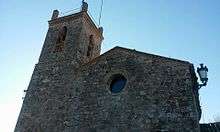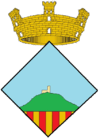Sant Martí de Maçana
| Maçana | ||
|---|---|---|
| Entity of Population | ||
|
Church of Sant Martí de Maçana | ||
| ||
 Maçana  Maçana Location in Catalonia | ||
| Coordinates: 41°41′13″N 1°36′12″E / 41.68694°N 1.60333°E | ||
| Country | Catalonia | |
| Province | Barcelona | |
| Comarca | Anoia | |
| Area | ||
| • Total | 24 km2 (9 sq mi) | |
| Elevation | 703 m (2,306 ft) | |
| Population (2014) | ||
| • Total | 39 | |
| • Density | 1.6/km2 (4.2/sq mi) | |
| Time zone | CET (UTC+1) | |
| • Summer (DST) | CEST (UTC+2) | |
Sant Martí de Maçana, or simply Maçana, is a small village situated in the municipality of Rubió, in the comarca of the Anoia, Catalonia. It is bordered to the north by Aguilar de Segarra and Els Prats de Rei, to the east by Castellfollit del Boix, to the south by Òdena and Rubió, and to the west by Els Prats de Rei and Rubió. It is to the north of the Serra de Rubió, in the valley of the Maçana river, tributary of the riera of Rajadell.[1] The village was formed by the different farms that are found around the hermitage of Sant Martí. It has a population of 39 inhabitants, as of 2014.[2]
Name and History
There are two theories about the origin of the name "Masana": one is from the Latin Mathiana, which means "apple" and the other is that comes from the Arabic ماسان ( Al-Mashana ). This name first appeared documented in 990. Also used until 1980 was the form Massana, and during the Franco era the name used was San Martin de Masana. During the 10th century there was a castle, possibly under the mandate of Saint Iscle.[3]

The church of San Martin, of Romanesque origin, was completely renovated in the seventeenth century without leaving too many traces of the Romanesque style. The old town was annexed to that of Rubió in 1840.
Coat of arms
The coat of arms of Maçana was established on the 15 November 2014, although not officially recognized. The crown represents the Turó de Maçana with the church of Sant Martí to the peak, and on the inferior part there is the senyera.
Church of Sant Martí de Maçana
San Martin de Masana is mentioned as a parish in 1154, within the old term Masana castle (now defunct). In the fourteenth century it was dedicated to San Acisclo. Its architecture is in the plan of a Latin cross and covered with a pointed vault. The pattern of the church is of St. Martin and St. Mark. Externally it is covered with a gabled roof and has a quadrangular bell attached to the church. Between 1975 and 1981 the church was restored. Also attached to the building is the rectory dating from 1736. We can also find the city cemetery next to the church. (2306 ft).[4]
Festivities
Maçana celebrates two popular festivities, in Spring and Autumn. The Autumn one celebrates Martí of Tours, patron of the church. Firstly the mass is held in the church, then a dance in the afternoon, and the raffle of a cake. The spring celebration is larger and is held on the nearest Sunday to 25 April. This is for Saint Marc, co-patron of the church. Again a mass in the morning, and the raffle of a cake, plus the distribution of the bread, and also a classical game called Conill Porquí (guinea pig).[5]
Geography

Maçana is situated to the south of the natural comarca of the Alta Segarra, on the north slope of the Serra de Rubió. Its geography is very rugged, formed by some of the valleys of the Serra de Rubió. The centre is the Turó de Maçana. The Còpia de Palomes, of 837 metres (2746 ft), the highest peak of Rubió, is situated to the northwest of Maçana. The river of Maçana, has several tributaries to the north of Serra de Rubió, which end in the river Cardener.[6]
Fauna
The fauna of Maçana is very diverse. Animals include the boar, the squirrel, the rabbit, the hare, the fox, the deer and the roe deer. There are also many varieties of birds, and wild fish.[7]
Notable residents
- Josep Ferrer Bujons: writer, poet, teacher and Catalan linguist, been born to Maçana the year 1959.[8]
References
- ↑ "Maçana" (PDF) (in Catalan). IDESCAT. Retrieved 2015-02-20.
- ↑ "El municipi en xifres. Territori." (in Catalan). Idescat.cat. Retrieved 2015-02-20.
- ↑ "L'església de Sant Martí de Maçana" (in Catalan). Catalunya Medieval. Retrieved 2015-02-20.
- ↑ "Church of Maçana" (in Catalan). Ajuntament de Rubió. Retrieved 2015-02-20.
- ↑ "Les festes majors de Maçana" (in Catalan). Festa Catalunya. Retrieved 2015-02-20.
- ↑ "Rutes a la Serra de Rubió" (in Catalan). Rutes Serra de Rubió. Retrieved 2015-02-20.
- ↑ "Routes for the forests of Maçana" (in Catalan). Rutes Serra de Rubió. Retrieved 2015-02-20.
- ↑ "Josep Ferrer i Bujons" (in Catalan). Lletres Catalanes. Retrieved 2015-02-20.

.svg.png)